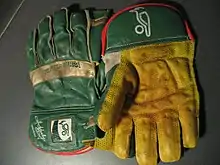Wicket-keeper's gloves
A wicket-keeper's gloves or mitt are large leather gloves worn by cricket players of the defending team which assist players in catching and fielding balls hit by a batsman or thrown by a teammate.

Construction
Wicket-keeper's gloves have an anterior surface designed for catching the ball, while offering protection to fingers and the palms of the hands from painful impact. Typically, the catching surface is made of rubber and has some traction-enhancing features, such as pimples. The catching surface is coloured yellow in the image shown above. Soft padding material is placed underneath the catching surface to reduce the impact of the ball. A protective padded cuff covering the wrist area is also present on the anterior surface, but this is typically leather-encased and does not offer a catching surface. This is the green, semi-circular piece on the glove to the right in the picture above. The posterior of the glove, which is not intended for contact with the ball, is made of leather and appears as the green backing of the glove on the left side in the picture shown. Inside the glove, rubber thimbles are used to protect fingertip from injury due to impact from the ball.
Legal specifications

Law 40.2, which deals with the specifications for wicketkeepers' gloves, states that: If,.... the wicket-keeper wears gloves, they shall have no webbing between the fingers except joining index finger and thumb, where webbing may be inserted as a means of support. If used, the webbing shall be:
(a) a single piece of non-stretch material which, although it may have facing material attached, shall have no reinforcements or tucks.
(b) such that the top edge of the webbing-
(i) does not protrude beyond the straight line joining the top of the index finger to the top of the thumb.
(ii) is taut when a hand wearing the glove has the thumb fully extended.[1]
Incidents and anecdotes
In 2008, Mahendra Singh Dhoni was instructed by the match referee in an Australia-India game at the Sydney Cricket Ground to change his wicket-keeping gloves, which were deemed to be in violation of Law 40.2.[2]
Wicket-keepers have been known to have a special bond with their equipment. Alan Knott, the legendary England wicket-keeper, is known to have worn his gloves in the evening at home to keep them supple. Jack Russell, yet another notable English keeper, allegedly slept with his gloves underneath his pillow.[3]
Knott is also known to have reinforced the protection offered by his gloves by taping pieces of plasticine to his inner gloves.[4] In fact, there are anecdotes circulating that some wicket-keepers in the olden days used to insert steaks inside their gloves for added padding.[5][6]
Major glove manufacturers
See also
- Cricket clothing and equipment
- Baseball glove a similar glove in a similar sport
References
- http://www.lords.org/laws-and-spirit/laws-of-cricket/laws/law-40-the-wicket-keeper,66,AR.html
- https://www.espncricinfo.com/story/_/id/22903144/dhoni-asked-change-wicketkeeping-gloves
- Woolmer, Bob; Noakes, Tim; Moffett, Helen (2008). Bob Woolmer's Art and Science of Cricket. Struik Publishers. p. 363. ISBN 978-1-77007-658-7.
- Woolmer, Bob; Noakes, Tim; Moffett, Helen (2008). Bob Woolmer's Art and Science of Cricket. Struik Publishers. p. 364. ISBN 978-1-77007-658-7.
- Woolmer, Bob; Noakes, Tim; Moffett, Helen (2008). Bob Woolmer's Art and Science of Cricket. Struik Publishers. p. 364. ISBN 978-1-77007-658-7.
- https://www.cricketcountry.com/articles/ernest-barberton-halliwell-the-man-who-first-put-raw-steaks-in-wicket-keeping-gloves-184326
